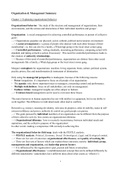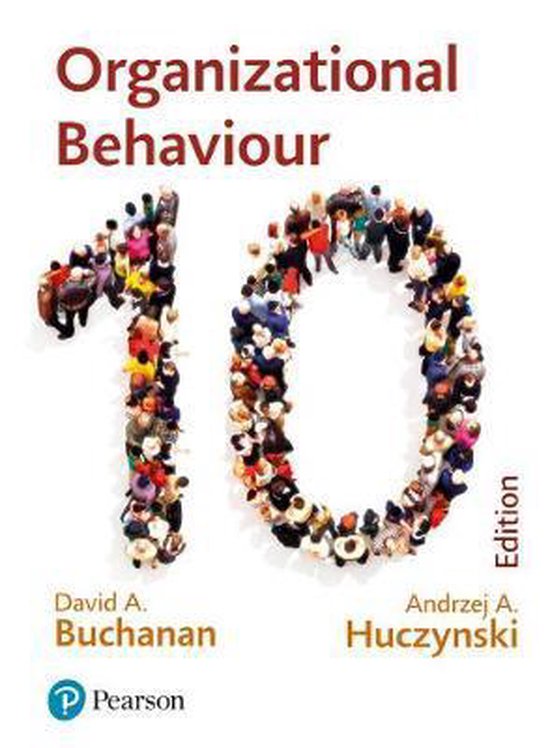Organization & Management Summary
Chapter 1: Explaining organizational behavior
Organizational behavior: ‘the study of the structure and management of organizations, their
environments, and the actions and interactions of their individual members and groups’.
Organization: ‘a social arrangement for achieving controlled performance in pursuit of collective
goals’.
—> Organizations populate our physical, social, cultural, political and economic environment.
—> A social arrangement is ‘a group of people who interact with each other because of their
membership’; so, this can also be a family, a WhatsApp group or the local street corner gang.
—> Controlled performance: ‘setting standards, measuring performance, comparing actual with
standard, and taking corrective action if necessary’. This need for controlled performance leads to
the creation of authority relationships.
—> Because of this need of controlled performance, organizations are distinct from other social
arrangements like a family, a WhatsApp group or the local street corner gang.
Morgan’s metaphors for organizations: machine, living organism, brain, culture, political system,
psychic prison, flux and transformation & instrument of domination.
Only using the managerial perspective is inadequate, because of the following reasons:
- Power inequalities: it’s important to focus on all people of an organization.
- The agenda: only shows important issues to managers, concerning control and performance.
- Multiple stakeholders: focus on all stakeholders, not only on management.
- Fashion victims: managerial insights are often subject to fashion.
—> Evidence-based management can be used to overcome these biases.
The main limitation to human aspiration lies not with intellect or equipment, but in our ability to
work together. The difference in individual needs often lead to conflicts.
Rewards (e.g. money), meaning (& identity, relevance & purpose), order & stability, status & self-
esteem/confidence and power, authority & control are goals people can pursue.
—> The goals pursued by individual members of an organization can be different from the purpose
of their collective activity: this creates an organizational dilemma.
—> Organizational dilemma: ‘how to reconcile inconsistency between individual needs and
aspirations, and the collective purpose of the organization’.
In other words: making a compromise. HR can help in achieving this.
The organizational behavior field map: deals with the PESTLE analysis.
—> PESTLE analysis: Political, Economic, Social, Technological, Legal, and Ecological context.
—> There are two sets of outcomes: organizational effectiveness, and quality of working life.
—> There are four sets of factors which can explain those outcomes, namely: individual, group,
management and organization, and leadership process factors.
—> It is influenced by the organization’s past, present and future events/plans.
—> Organizational effectiveness: ‘a multidimensional concept that can be defined differently by
different stakeholders’ (stakeholders have different ideas about what counts as ‘effective’).
1
,—> Quality of working life: ‘an individual’s overall satisfaction with their job, working
conditions, pay, colleagues, management style, organization culture, work-life balance, and training,
development and career opportunities’. It’s also linked to organizational effectiveness.
Balanced scorecard: ‘an approach to defining organizational effectiveness using a combination of
quantitative and qualitative measures, such as environmental concerns, employee development etc.’
Fundamental attribution error: ‘the tendency to explain the behavior of others based on their
personality or disposition, and to overlook the influence of wider contextual influences’.
—> For example, only blaming the bad waitress for her bad service.
—> We need to be aware of how the context affects behavior as well: so for example, context
factors, individual factors, group factors, structural factors and/or management process factors could
play a role in this bad service of the waitress.
Social science, like psychology and organizational behavior, often raises more questions than it
answers, unlike natural science (like computing or electrical engineering).
With the goals of science (stated below) come different problems for social science, which isn’t
present with the natural science, as you can see in the table below.
Goals of science Practical implications Social science problems
Description Measurement Invisible and ambiguous
variables
People change over time
Explanation Identify the time order of Timing of events not always
events clear
Establish causal links between Cannot always see interactions
variables
Prediction Generalizing from one setting Uniqueness, complexity and
to another lack of comparability between
settings
Control Manipulation Ethical and legal constraints
Table 1.1: goals of science and social science problems
Explaining organizational behavior
The natural sciences are based on an approach known as positivism.
—> Positivism: ‘a perspective which assumes that the world can be understood in terms of causal
relationships between observable and measurable variables, and that these relationships can be
studied objectively using controlled experiments’.
—> The term ‘scientific’ is often used to mean a positivist approach that is objective and rigorous,
using observations and experiments to find universal relationships.
To measure something, you need an operational definition: ‘the method used to measure the
incidence of a variable in practice’.
—> For example, your used operational definition can be misleading in social science, because you
have to look at the involved persons and how they interpret their own actions, not how you view it.
2
,Variance theory: ‘an approach to explaining organizational behavior based on universal
relationships between independent and dependent variables which can be defined and measured
precisely’.
—> This theory offers definitive explanations where the links between causes and outcomes do not
change.
—> Our field map can be read as a ‘cause and effect’ explanation, with the independent variables
on the left.
Constructivism: ‘a perspective which argues that our social and organizational worlds have no
ultimate objective truth or reality, but are instead determined by our shared experiences, meanings
and interpretations’.
—> Used for the study of social sciences.
—> Constructivism argues that we are self-interpreting beings, who attach meaning and purpose to
what we do.
Process theory: ‘an approach to explaining organizational behavior based on narratives which
show how several factors, combining and interacting over time in a particular context, are likely to
produce the outcomes of interest’.
—> Shows how a sequence of events, in a given context, leads to the outcomes in which we are
interested.
—> This theory offers probabilistic explanations; combinations of factors are more or less likely to
generate the outcomes of interest, but not always.
Positivsm Constructivism
Description Accepts information that can be Accepts qualitative information,
observed and quantified and relies on inference; studies
consistently local meanings and
interpretations
Explanation Uses variance theories Uses process theories
Relies mainly on observable Relies mainly on qualitative
quantitative data and data and self-interpretations
measurements Develops explanatory narratives
Seeks universal laws based on based on factors combining and
links between independent and interacting over time and in
dependent variables context
Prediction Based on the knowledge of Based on shared understanding
stable and consistent and awareness of multiple social
relationships between variables and organizational realities
Predictions are deterministic Predictions are probabilistic
Control Aims to shape behavior and Aims at social and
achieve desired outcomes by organizational change through
manipulating explanatory stimulating critical self-
variables awareness
Table 1.5: Positivism vs. constructivism: a summary
3
, Management decisions should be based on evidence, rather than on habit, bias or false assumptions.
—> Evidence-based management: ‘systematically using the best available research evidence to
inform decisions about how to manage people and organizations’.
—> There’s also a movement called evidence-based management movement (EBMgt).
—> Problems with this movement: for example, academic articles are designed to persuade.
—> Because of these problems, people came up with the terms ‘evidence-informed’ and ‘evidence-
aware’.
Human resource management: OB in action
Human resource management (HR): ‘the function responsible for establishing integrated
personnel policies to support organization strategy’.
—> In designing those policies, HR is ‘OB in practice’. This applies to the stages of the
employment cycle: ‘the sequence of stages through which all employees pass in each working
position they hold, from recruitment and selection, to termination’.
—> HR policies are independent variables; the quality of working life and organizational
effectiveness are dependent variables.
HR must make that that employees have…
- Ability: have job skills and knowledge, including how to work well with others.
- Motivation: feel motivated to do the work and do it well.
- Opportunity: be able to use skills, and contribute to team and organizational success.
The idea of the Bath Model (of HR) is that high performance work practices increase
organizational profitability.
—> It deals with the AMO factors, described above: these factors are needed for people to perform
beyond the minimum requirements of a job.
—> Discretionary behavior: ‘the freedom to decide how work is going to be performed;
discretionary behavior can be positive, such as putting in extra time and effort, or it can be negative,
such as withholding information and cooperation’.
Big data and the HR contribution
Big data: ‘information collected, often real-time, from sources such as internet clicks, mobile
transactions, user-generated content, social media, sensor networks, sales queries, purchases’.
—> May cause the low impact of HR policies to change.
—> Big data contributes to HR management by providing objective information on which to base
decisions and solve HR problems.
—> Data analytics: ‘the use of powerful computational methods to reveal and to visualize patterns
and trends in very large sets of data’.
—> Human capital analytics: ‘an HR practice enabled by computing technologies that use
descriptive, visual and statistical analyses of data related to HR processes, human capital,
organizational performance and external economic benchmarks to establish business impact and
enable evidence-based, data-driven decision-making’.
4






